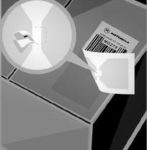
Kuwait’s Ministry of Justice uses RFID technology to track documents
[ad_1]
After the case has been filed in the Judicial Palace of the Ministry of Justice of Kuwait, court employees can log in to the software to view the last known location of the files related to the case. The technology is provided by Litum Technology and Innovative, a local startup company in Kuwait.
The office handles thousands of new cases every month, and each case needs to use a folder to hold some documents for processing, review, and submission to the court, and finally to file. The department employs 200 couriers to transport documents between departments. In addition, people in other departments sometimes take documents to other offices or leave them in other offices. Since these documents move frequently, finding them becomes a very difficult task. Sometimes, the folder is found, but the file is lost. When these documents are necessary for the prosecution or defense of the case, this becomes a serious problem.

Sulaiman Al-Mansour, director of the Department of Justice’s operations department, said that as a result, Ministry of Justice staff usually spend a lot of time searching for folders and documents. This slow process is likely to delay judicial procedures within the court.
Therefore, the Ministry of Justice introduced an RFID system to check the location of folders and issue warnings when files leave the Ministry of Justice. Al-Mansour said: “The system is currently in the first phase. We will extend the scope of the system to all courts in the future.”
Litum provided the hardware and software, and Innovative installed the technology. Innovative Intellectual Director Ahmed Hassan said that about a year ago, the Ministry of Justice contacted Innovative. The company and Litum have developed an IT asset management system using EPC Gen 2 passive UHF RFID tags, and employees can use handheld readers for tracking.
However, in the matter of document tracking, the Ministry of Justice needs to use a fixed reader to automatically collect data on millions of folders on key positions such as the desks of salesmen or lawyers. Hassan said: “We designed this system to track the location of documents before they were sent to the court.”
Alp ülkü, Litum’s business development manager, said that the company has installed 48 fixed readers at the door and on the desktop. The system uses five Impinj R420 UHF RFID reader entrances and Litum 11 dBic reader antennas on three floors of the building.
Litum provides ThingMagic USB desktop reader and Smartrac Frog 3D EPC Gen 2 passive UHF RFID embedded in folders and documents.
Whenever there is a new case, an RFID tag will be attached to the new case document, and then the Litum document tracking software will store the relevant ID number. Important documents will be stored in folders (certification information or signed documents), each page will be attached with a label, and the label ID will also be bound to the stored folder label ID.
Then, the folder will be submitted to the desk of the person involved in the case, such as a clerk or lawyer. Since it is not practical to install entrance readers at each office gate, the Ministry of Justice only installed entrance readers in a few key areas and installed desktop readers on employee desktops to read specific data. In this way, when the document is sent from the storage rack to the desk of the personnel, the fixed reader and the desktop reader will read the tag ID. These data will also be transferred to the file tracking software for location status updates.
The staff can log in to the software, enter the case number, and view the location of the folder based on the tag and the location that was last read.
The software can also provide alarms when abnormal. For example, if a worker transports 10 folders, and each folder contains 10 files with tags, the reader will only read 9 tags, so the software will find potential problems. Then, the staff will receive a reminder email. Hassan stated that the software initially installed an audible alarm device at each reader, but the Department of Justice finally chose email notifications. He explained: “Sound alarms will affect work. So we chose quiet email.” In addition, if an employee leaves the RFID exit of the main exit gate with a folder ID, an alarm will sound at the exit.
Each employee wears a badge with a built-in Smartrac label. The badge ID number and employee identification information are bound to each other and stored in the software. When an employee brings a file through the RFID portal, the software will know the information of the file carrier.
In addition, when an employee who is not wearing a badge or an unauthorized employee leaves the office building with documents, the system will issue a warning. However, there are some exceptions. For example, judges can carry documents out of the office building without wearing a badge. In this case, the judge can use a desktop reader to read the document label and bind the identity information. In this way, the software will update the status of the file.
If court staff are looking for documents in a certain area, they can enter the relevant ID number on the Atid AT880 portable reader, and then move around the area with them.
Since the installation of the system, the time spent searching for files has been reduced, and the staff have become more responsible. So far, the Ministry of Justice has ordered 500,000 labels.
(Exclusive manuscript of rfid world network, please indicate the source author for reprinting!)
[ad_2]



